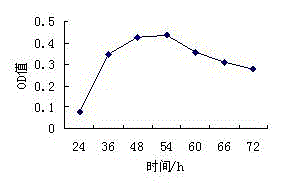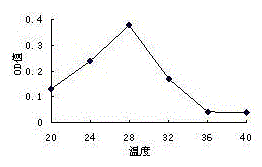Bacterium strain capable of producing haematochrome and method for preparing haematochrome
A technology for red pigments and strains, applied in microorganism-based methods, biochemical equipment and methods, bacteria, etc., to achieve the effects of simple equipment, easy extraction, and reduced extraction costs
- Summary
- Abstract
- Description
- Claims
- Application Information
AI Technical Summary
Problems solved by technology
Method used
Image
Examples
Embodiment 1
[0053] Described bacterial strain adopts following method to prepare:
[0054] (1) Separation of strains:
[0055] Collect the soil, weigh the soil sample and put it into the instrument, then add sterile water, the mass volume ratio of the soil sample to the sterile water is 1:8, shake at a speed of 140r / min for 25min, let it stand for 25min and then dilute it 10 times gradiently, draw 200uL of diluent, spread on Gaoshi No. 1 solid medium, beef extract peptone and PDA medium respectively, and incubate at a constant temperature of 26°C for 1-5d; the soil is dry soil under a weak light environment, which can be sandy Soil, generally choose the soil under the shade of trees, with no obvious moisture on the surface.
[0056] Among them, the formula of Gaoshi No. 1 solid medium is: 19 parts of soluble starch, KNO 3 0.8 parts, NaCl 0.4 parts, K 2 HPO 4 ·3H 2 O0.4 parts, MgSO 4 ·7H 2 O0.4 parts, FeSO 4 ·7H 2 O0.008 parts, 17 parts of agar, 0.98L of distilled water, pH7.1;
...
Embodiment 2
[0066] Described bacterial strain adopts following method to prepare:
[0067] (1) Separation of strains:
[0068] Collect the soil, weigh the soil sample and put it into the instrument, then add sterile water, the mass volume ratio of the soil sample and sterile water is 1:9, shake at a speed of 160r / min for 25min, let it stand for 35min and then dilute it 9 times gradiently, draw 195uL of the dilution solution is spread on Gaoshi No. 1 solid medium, beef extract peptone and PDA medium respectively, and cultured at a constant temperature of 29°C for 1-5d; the soil is dry soil under a weak light environment, which can be sandy Soil, generally choose the soil under the shade of trees, with no obvious moisture on the surface.
[0069] Among them, the formula of Gaoshi No. 1 solid medium is: 21 parts of soluble starch, KNO 3 1.2 parts, NaCl 0.6 parts, K 2 HPO 4 ·3H 2 O0.6 parts, MgSO 4 ·7H 2 O0.6 parts, FeSO 4 ·7H 2 O0.012 parts, 19 parts of agar, 1.2L of distilled water...
Embodiment 3
[0079] Described bacterial strain adopts following method to prepare:
[0080] (1) Separation of strains:
[0081] Collect the soil, weigh the soil sample and put it into the instrument, then add sterile water, the mass volume ratio of soil sample to sterile water is 1:8-9, shake at 140-160r / min for 25-35min, let stand for 25- After 35 minutes, 11-fold gradient dilution was taken, and 205uL of the diluted solution was drawn, and spread on Gaoshi No. 1 solid medium, beef extract peptone and PDA medium respectively, and incubated at a constant temperature of 26-29°C for 1-5d; the soil was weakly illuminated The dry soil in the environment can be sandy soil. Generally, the soil under the shade of trees and without obvious moisture on the surface is selected.
[0082] Among them, the formula of Gaoshi No. 1 solid medium is: 20 parts of soluble starch, KNO 3 1.1 parts, NaCl 0.55 parts, K 2 HPO 4 ·3H 2 O0.5 parts, MgSO 4 ·7H 2 O0.5 parts, FeSO 4 ·7H 2 O0.009 parts, 18 parts...
PUM
| Property | Measurement | Unit |
|---|---|---|
| absorbance | aaaaa | aaaaa |
Abstract
Description
Claims
Application Information
 Login to View More
Login to View More - R&D
- Intellectual Property
- Life Sciences
- Materials
- Tech Scout
- Unparalleled Data Quality
- Higher Quality Content
- 60% Fewer Hallucinations
Browse by: Latest US Patents, China's latest patents, Technical Efficacy Thesaurus, Application Domain, Technology Topic, Popular Technical Reports.
© 2025 PatSnap. All rights reserved.Legal|Privacy policy|Modern Slavery Act Transparency Statement|Sitemap|About US| Contact US: help@patsnap.com



